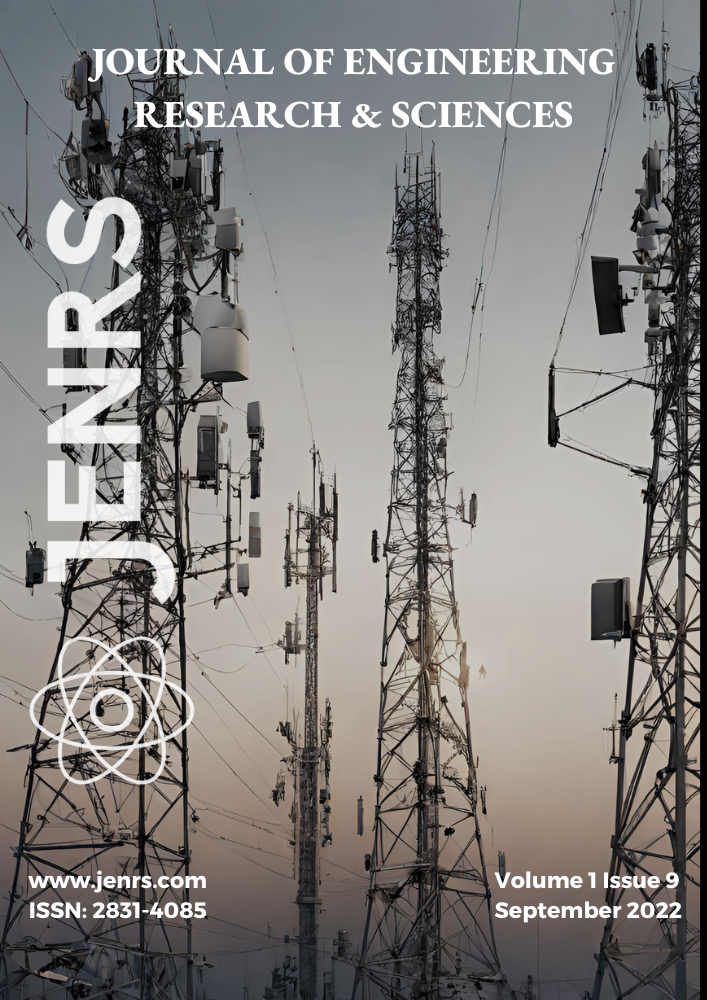
Publication Month: January 2022, Page(s): A1 – A1
Publication Month: January 2022, Page(s): B1 – B1
Publication Month: January 2022, Page(s): C1 – C1
Publication Month: January 2022, Page(s): D1 – D1
Suleyman Meliksah Yayan Ali Furkan Aslan
J. Engg. Res. & Sci. 1(9), 1-7 (2022);
In this work, complementary split ring resonators (CSRR) based broadband monopole antenna is proposed. A variety of geometrical shapes are studied as a radiator to find out the radiator with the highest possible return loss bandwidth potential. It has been found that the semi-circularly shaped resonator has the widest VSWR<3 bandwidth. Therefore, a monopole antenna constructed by a semi-circularly shaped microstrip radiator which is excited with a 50-ohm microstrip line is proposed. It has been seen that a semi-circularly shaped microstrip radiator does not have adequate broadband performance in terms of VSWR<2 bandwidth. Therefore, CSRR structures that are shaped like hexagons are employed in order to enhance the VSWR<2 bandwidth of the proposed antenna. It has been seen that a single CSRR only influences a limited frequency range. In order to make the proposed monopole antenna operate within a much larger frequency bandwidth and achieve return loss enhancement along the whole frequency band, multiple equilateral hexagonal CSRRs are utilized. The ground plane of the monopole antenna is modified such that three CSRR structures having different dimensions are inserted behind the 50-ohm feeding line. The resulting manufactured monopole antenna operates from 320 MHz to 1100 MHz while having an average gain of 3.05 dBi gain. Moreover, the total efficiency of 94% is achieved along the operating frequency band.
Zainab Jawad Ahmed, Loay Edwar George, Raad Ahmed Hadi
J. Engg. Res. & Sci. 1(9), 8-14 (2022);
Some problems want to be solved in image compression to make the process workable and more efficient. Much work had been done in the field of lossy image compression based on wavelet and Discrete Cosine Transform (DCT). In this paper, an efficient image compression scheme is proposed, based on a common encoding transform scheme; It consists of the following steps: 1) bi-orthogonal (tab 9/7) wavelet transform to split the image data into sub-bands, 2) DCT to de-correlate the data, 3) the combined transform stage’s output is subjected to scalar quantization before being mapped to positive, 4) and LZW encoding to produce the compressed data. The peak signal-to-noise (PSNR), compression ratio (CR), and compression gain (CG) measures were used to perform a comparative analysis of the performance of the whole system. Several image test samples were used to test the performance behavior. The simulation results show the efficiency of these combined transformations when LZW is used in the field of data compression. Compression outcomes are encouraging and display a significant reduction in image file size at good resolution.
Ya-Ning Chang, Chui-Yu Chiu
J. Engg. Res. & Sci. 1(9), 15-32 (2022);
The spread of the epidemic caused many people to believe the traditional office model is no longer appropriate for modern business, nor is it compatible with the efficiency and innovation demanded by modern business. Individual accomplishment is not measured by where one works, but by achieving a balance between work and life and establishing a connection in the world. No matter where we sit, the energy and thinking we bring to our work will help us accelerate the creation of flexible work models. In 2022, business leaders are dealing with vaccines and back-to-office issues. At the same time, we began to think about a new working model, after listening to the employees’ opinions and determining what conditions must exist for collaboration with organizational leaders to succeed. The purpose of this paper is to explore the possibility of using the Delphi method (Delphi) and SWOT method to conduct in-depth interviews with current IT professionals in applying hybrid work models with critical success factors (CSFs) after COVID-19 hoping to bring new ideas and inspirations to business leaders in Taiwan.
This sidebar is currently being updated and may temporarily overlap with the pages.

This work is licensed under a Creative Commons Attribution-ShareAlike 4.0 International License.